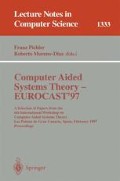Abstract
In order to build models reflecting accurately the structure of the real world Artificial Intelligent-based systems have the difficult problem of reducing the continuous, extremely complex sensory information into a discrete and simple model with the optimal computational burden. The new concept of sensory gradient is introduced in this paper to obtain computational models of the sensory information available for an autonomous mobile robot. The main objective is to guarantee that these models are simple and at the same time powerful enough to allow the performance of complex navigation tasks. We use the sensory gradient's module to identify situations and places that must be recorded (we call them Relevant Sensory Places or RSPs for short) and we build upon these RSPs a graph-based model of the universe that allows to develop navigation plans using plan-as-communication techniques. This novel approach is applied to the spatial reasoning problem as an aid to the autonomous navigation of mobile robots. Using a simulation environment the paper presents some empirical results which have been very encouraging. This novel approach has been successfully tested on a NOMAD-200 mobile robot platform.
This project has been partly funded by the Comisión Interministerial de Ciencia y Tecnología (CICYT) under contract TAP94-0656-CO3-03
Preview
Unable to display preview. Download preview PDF.
References
Agre, R. E.; Chapman, D. 1990. What are Plans for? Designing of Autonomous Agents. P. Maes (ed). Cambridge, MA, MIT Press. pp. 17–34.
Brooks, R. Mataric, M. 1993. Real Robots, Real Learning Problems, in Connell, J. H.; Mahadevan, S. (eds.). Robot Learning. Kluwer Academic Publishers. pp. 193–213.
Elfes, A. 1991. Dynamic Control of Robot Perception Using Stochastic Spatial Models. Proceedings of the International Workshop on Information Processing in Mobile Robots. pp. 203–218.
Hofstadter, D. R. 1979. Gödel, Escher, Bach, an Eternal Golden Braid. Basic Books.
Kohonen, T. 1982. Self-Organized Formation of Topologically Correct Feature Maps. Biological Cybernetics 43. pp. 59–69.
Kuipers, B.; Byun, Y. 1988. A Robust, Qualitative Approach to a Spatial Learning Mobile Robot. SPIE Vol. 1003 Sensor Fusion: Spatial Reasoning and Scene Interpretation. pp. 366–375.
Kumpel, D.; Serradilla, F. 1990. Robot Navigation Systems in a Partially Known Environment Using a Space-Time Learning Graph. Proceedings of CIM-Europe 6th Annual Conference. pp. 65–75.
Nilsson, N. J. 1980. Principles of Artificial Intelligence. Palo Alto, Ca., Tioga Publishing Company.
Payton, D. 1991. Internalized Plans: A Representation for Action Resources. In Designing Autonomous Agents. P. Maes (ed). MIT Press. pp. 89–103.
Pierce, D.; Kuipers, B. 1994. Learning to Explore and Build Maps. Proceedings of the Twelfth National Conference on Artificial Intelligence. Vol. 2. MIT Press. pp. 1264–1271.
Serradilla, F.; Maravall, D. 1996. A Navigation System for Mobile Robots Using Visual Feedback and Artificial Potential Fields. Proceedings of the Thirteenth European Meeting on Cybernetics and System Research. Trappl, R (ed.). pp. 1159–1164.
Shen, W. 1994. Autonomous Learning from the Environment. Computer Science Press.
Author information
Authors and Affiliations
Editor information
Rights and permissions
Copyright information
© 1997 Springer-Verlag Berlin Heidelberg
About this paper
Cite this paper
Serradilla, F., Maravall, D. (1997). Cognitive modeling for navigation of mobile robots using the sensory gradient concept. In: Pichler, F., Moreno-Díaz, R. (eds) Computer Aided Systems Theory — EUROCAST'97. EUROCAST 1997. Lecture Notes in Computer Science, vol 1333. Springer, Berlin, Heidelberg. https://doi.org/10.1007/BFb0025049
Download citation
DOI: https://doi.org/10.1007/BFb0025049
Published:
Publisher Name: Springer, Berlin, Heidelberg
Print ISBN: 978-3-540-63811-7
Online ISBN: 978-3-540-69651-3
eBook Packages: Springer Book Archive

